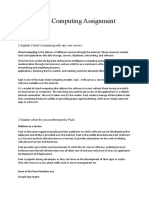MASTERING CLOUD COMPUTING: KEY CONCEPTS AND SERVICES
A Comprehensive Guide to Understanding Cloud Computing and Its Services
INTRODUCTION
Cloud computing has revolutionized how businesses and individuals access
computing resources. By leveraging the power of the internet, cloud services offer
flexible, scalable, and cost-effective solutions that have become integral to
modern technology. This guide provides an in-depth overview of cloud computing,
the different types of cloud services, and how businesses and developers can
leverage them for success.
1. WHAT IS CLOUD COMPUTING?
Cloud computing refers to the delivery of computing services—such as servers,
storage, databases, networking, software, and analytics—over the internet (the
cloud). Rather than owning and maintaining physical servers or data centers,
organizations can rent these resources on-demand, paying only for what they
use.
On-Demand Self-Service:
Users can provision resources such as virtual machines or storage from the cloud
provider's data center with minimal human intervention.
Broad Network Access:
Cloud services are accessible over the internet from a wide range of devices,
such as smartphones, laptops, and desktops.
Resource Pooling:
Cloud providers pool computing resources to serve multiple customers, offering
economies of scale and flexibility.
Rapid Elasticity:
�Cloud computing resources can be quickly scaled up or down based on demand.
This elasticity ensures that businesses can efficiently handle fluctuating
workloads.
Measured Service:
Resources are metered, and customers are billed according to usage, allowing
for cost efficiency.
2. TYPES OF CLOUD COMPUTING MODELS
Cloud computing services are delivered in different models, each offering
different levels of control, flexibility, and management. The three primary models
are:
Infrastructure as a Service (IaaS):
IaaS provides virtualized computing resources over the internet. It includes virtual
machines, storage, and networking components. IaaS allows businesses to rent
infrastructure and scale resources according to demand without worrying about
hardware management.
Example Providers: Amazon Web Services (AWS), Microsoft Azure, Google
Cloud Platform (GCP).
Platform as a Service (PaaS):
PaaS offers a platform and environment for developers to build, deploy, and
manage applications without managing the underlying hardware or software.
PaaS includes tools for software development, testing, and deployment.
Example Providers: Google App Engine, Heroku, Microsoft Azure App Services.
Software as a Service (SaaS):
SaaS delivers software applications over the internet on a subscription basis.
Users can access applications through a web browser, and the software provider
handles updates, maintenance, and infrastructure.
�Example Providers: Google Workspace, Microsoft 365, Salesforce.
3. KEY CLOUD SERVICES
Cloud services come in various forms, addressing different needs of businesses
and individuals. Below are some of the most commonly used cloud services:
Compute Services:
These services allow users to run applications and manage virtual machines.
Cloud compute services are ideal for hosting web applications, databases, and
enterprise systems.
Example: AWS EC2, Google Compute Engine, Microsoft Azure Virtual Machines.
Storage Services:
Cloud storage services allow users to store and manage data online. These
services offer scalability and reliability, with automatic backups and redundancy
to ensure data availability.
Example: AWS S3, Google Cloud Storage, Microsoft Azure Blob Storage.
Database Services:
Cloud providers offer managed database services that allow users to run
relational and non-relational databases without the overhead of managing
hardware.
Example: Amazon RDS, Google Cloud SQL, Microsoft Azure SQL Database.
Networking Services:
Cloud networking services ensure the smooth transfer of data between cloud
resources and external systems. These services often include load balancing,
virtual private networks (VPNs), and content delivery networks (CDNs).
Example: AWS VPC, Google Cloud VPC, Microsoft Azure Virtual Network.
Machine Learning and AI Services:
�Many cloud providers offer machine learning platforms and APIs to help
developers build and deploy AI models. These services are often fully managed,
providing tools for data processing, model training, and deployment.
Example: Google AI, AWS SageMaker, Azure AI.
4. CLOUD COMPUTING SECURITY
While cloud computing offers many benefits, it also introduces new security
concerns. It's important to implement proper security measures to protect data,
applications, and infrastructure in the cloud.
Data Encryption:
Data should be encrypted both in transit and at rest to prevent unauthorized
access. Cloud providers often offer built-in encryption options.
Identity and Access Management (IAM):
Cloud providers offer IAM services to control who can access resources in the
cloud. Proper role-based access control (RBAC) ensures that only authorized
individuals have access to critical systems.
Disaster Recovery:
Cloud services typically include disaster recovery options such as data backups,
multi-region redundancy, and failover mechanisms, ensuring business continuity
in case of hardware failure or other disasters.
Compliance:
Many organizations need to comply with specific regulations (e.g., GDPR, HIPAA)
when handling sensitive data. Cloud providers offer compliance certifications and
security controls to help businesses meet regulatory requirements.
�5. BENEFITS OF CLOUD COMPUTING
Cloud computing offers a range of benefits that make it an attractive choice for
businesses and developers:
Cost Efficiency:
Cloud computing eliminates the need for large capital expenditures on hardware
and reduces operational costs. Users only pay for the resources they use, which
ensures that businesses can scale their operations affordably.
Scalability:
The ability to scale cloud resources up or down quickly allows businesses to meet
demand efficiently, avoiding over-provisioning and underutilization of resources.
Flexibility and Accessibility:
Cloud services can be accessed from any device with an internet connection,
enabling remote work and collaboration.
Faster Time to Market:
Cloud computing allows businesses to deploy applications and services quickly,
accelerating time-to-market for new products.
6. THE FUTURE OF CLOUD COMPUTING
Cloud computing is continuously evolving, and its future looks promising. Key
trends to watch include:
Edge Computing:
Edge computing refers to processing data closer to the location where it is
generated, rather than relying solely on centralized cloud data centers. This is
especially useful for IoT applications that require low latency.
Serverless Computing:
�Serverless computing allows developers to build and run applications without
managing servers. Cloud providers automatically handle infrastructure
provisioning and scaling, simplifying the development process.
Hybrid and Multi-Cloud Strategies:
Many organizations are adopting hybrid cloud solutions that combine private and
public cloud resources. Multi-cloud strategies involve using services from
different cloud providers to avoid vendor lock-in and ensure redundancy.
CONCLUSION
Cloud computing has transformed the way businesses operate, offering
unprecedented flexibility, scalability, and cost-effectiveness. As cloud
technologies continue to evolve, businesses and developers who embrace cloud
services will be better positioned to innovate, scale, and succeed in the digital
age. By understanding the key concepts and services in cloud computing,
companies can unlock the full potential of the cloud and drive their operations
forward.





















































































